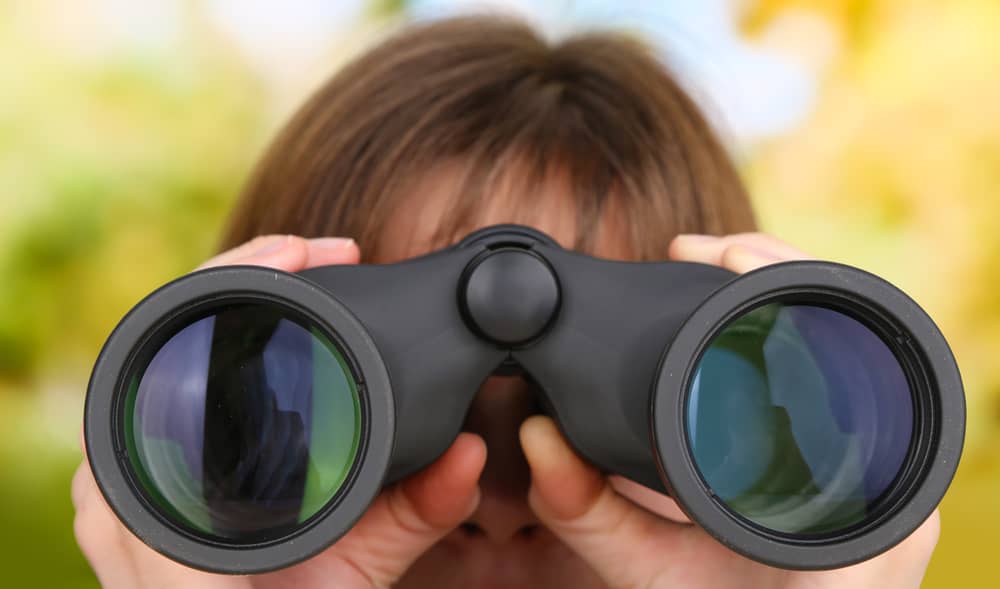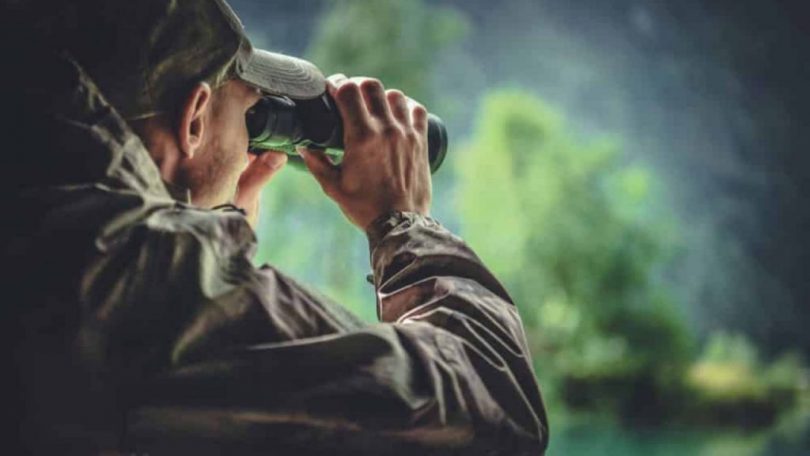A pair of binoculars is considered as effective when it produces images that are bright, aberration-free –with the right proportion of sharpness.
It provides its viewers with the appropriate appearance of an image regardless of the distance, once both optical lenses are rightly adjusted.
But how do we use it the right way? How to focus binoculars for different distances?
Let’s find out together!
The act of focusing the ocular is one of the common challenges most people using binoculars encounter, as more than 80% of them seem to find the entire process a bit more technical than normal.
The ability of a pair of binoculars to autofocus itself either automatically or manually is what makes the stack difference between the worst binoculars and those binoculars with advantages.
Adhering to the following information below can increase your ability to get the most out of a pair of good-quality binoculars.
How to Focus Binoculars: Step-By-Step Guide

1. Set Eyepiece Spacing
The interpupillary (IPD) which is the distance that exists between our eyes varies greatly, but it ranges between 56mm to 76mm, with a common average range of 66mm.
So the first step to start out with is to hold the binocular in its regular viewing position.
Once both barrels are firmly grasped with both hands, then you could move them either farther apart or closer together until you have a perfect view of the image in the circular viewing field.
If you have a binocular with an IPD scale, go through its setting for more reference.
You will be required to readjust once you have an object that is close-focused.
With enough practice, you will grow your ability to focus the binoculars within seconds.
2. Choose Eyecup Height
Most contemporary binoculars and monoculars are designed with adjustable eyecups.
The eyecups serve a double function; it positions the eye pupils to the correct position from the eyepiece and eliminates extraneous sidelight to enable you to view a full field.
The most common type of eyecups is rolling down, twisting up, or pop-up. The eyecups are located in the upper position for non-eyeglass users.
While for glass users, it is located at the down position.
From the normal traditional, the eyecups can be repositioned to suit your needs; this appears to be easier if you are used to modern eyecups that are designed with intermediate positioning.
3. Focus the Lenses
There are three major categories of focusing systems; these are:
- The Centre focuses on a diopter adjustment.
- The individual focus requires the focusing of an eyepiece individually.
- The fixed focus is always pre-focused for a particular viewing range of distance.
The center-focus binoculars are the common types of binoculars at the side of the center-focusing wheel.
At the side of the central focusing wheel is a diopter adjustment that is designed to help out with visions that are unequal and most times appear between both eyes of the viewers.
The diopter has an adjustment scale that shows a positive (+) and a negative (-) diopter adjustment on both sides of the Zero marker, which is designed with a focusing, which is located on the right side of the eyepiece.
Diopter that is located in the position modified to the precise optical system.
Although some models are built with their diopter setting attached at the left side of the eyepiece, which is designed to regulate the left optical system.
4. Focus Non-Diopter Side
You can choose to use your hand or a lens cover to cover the front lens (objective lens) that is located at the sides of your binoculars with a diopter setting.
You can use the center focus wheel to focus on objects that are far away, like trees and birds.
5. Adjust the Diopter setting
While being cared for with the settings of each center focus wheel, remove any form of coverage from the objective lens that is found close to the diopter side.
Cover up the front lens (objective lens) and try to view a tree using the other eye.
Now use the diopter setting and try to pay more attention to the branches of the trees until you have a better and more detailed shape again.
Once that is done, the clarity of the tree should increase when using both eyes.
If the binocular doesn’t produce clearer vision, then try the entire process again.
This time around, turn the center focus wheel. If the binoculars have a diopter scale, try to note the current setting for future purposes.
Once you keep up with the practice, you become more familiar with the entire procedure and will be able to do it in a minute.
(A reversal in the entire procedure can frustrate an individual’s effort and also decrease your chances of getting the desired focus).
6. Focus on Both Sides
Due to its simplicity, imperviousness, and ruggedness to water, contaminants, and dust from the atmosphere has a lesser effect on its performance.
In most cases military use individual binoculars.
Just as the saying goes “Focus both sides,” it’s designed to have a focusing system that can be regulated independently simply by rotating the diopter adjustment, which is located close to the eyepiece.
In some cases, it can be irritating, especially if you intend to focus on an object that is located at a distance.
The focus binocular gives its user the chance to make an adjustment for long ranges or intermediate and refocus if need be.
The binoculars are designed with zero-focusing systems. The binocular optics is pre-focus permanently for people with 20/20 vision.
It is specially designed for people who use contact lenses or glasses to aid their sense of vision or for those with normal vision.
Although most owners with fixed focus binoculars are of the option that the device is designed with autofocus.
This occurrence is brought about by the eye-focusing ability, which is triggered by the distances at which the object appears.
7. Adjust the Diopter Setting
The diopter adjustment setting is done with the aid of the knob located at the top of the binocular.
It is primarily designed to compensate for that exit between your eyes.
You can focus the binoculars simply y turning the knob located in the center.
Diopter Adjustment on the Right Part of the Eyepiece
The central focusing knob is used to focus the barrels of the binoculars.
To make adjustments between the eyes, the diopter adjustment can be used to regulate only the right barrel.
Once the left barrel is adjusted, both sides of the binoculars will automatically get focused, regardless of the object’s distance.
Regulate the diopter setting to the center or at zero level position.
Some binoculars have a zero at the center diopter regulating scale. The central position is represented with different symbols.
You can either rotate the ring to the right or to the left-center position.
Close the barrel that is affected by the diopter adjustment. You can use a lens cap or request the assistance of a friend to assist using a hand.
View an object from a middle distance and spot a shape that is static, like a ceramic turtle.
Try to focus on the binoculars by keeping both of your eyes open until you have an image that is sharp and clear enough.
Avoid squinting one eye.
Once your eye is tightly closed, the pressure on the eyeball will increase, and this can affect the eyes and lead to some changes in the shape and clarity of the object viewed under the binoculars.
Once the left eye is rightly focused, try to use the diopter to focus on the other part of the eye.
Keep the central focus wheel in the position you set.
Try to change the cap of the lens; this will enable you to see the other part of the barrel.
Stand in the same location and view the object the way you did initially.
This time around, try to keep both eyes open, the right eye will produce a dominant appears.
If you intend to tune the right eye focus, try to adjust the setting of the diopter forward or backward till you have a clear and sharp focus.
Once you get your desired sharpness, take away the cap of the lens, and try viewing through both of the eyepieces at the same time.
Diopter Adjustment on the Center Column
There are some binoculars designed with diopter adjustment that is located at the column.
You must know how to adjust the diopter on the center column.
Besides, you should also understand what the numbers on binoculars mean to get the best view through a pair of binoculars. The step for adjusting the diopter is all the same.
- Use the cap to cover the right part of the lens.
- Use the central focusing ring to focus on the middle ground object.
- Substitute the cap of the lens; this will help you see through.
- Try to focus on the same object viewing it with both of your eyes open.
- Try to remove the cap of the lens, and this will create a perfect view
Equipped with this understanding of the diopter adjustment, you can allow your binoculars to do their best for you.
Whether you’re using night vision binoculars or hunting binoculars, focusing the device is not much of a daunting task as many may think.
The rule is simple – practice until you experience some degree of perfection.









Leave a Comment